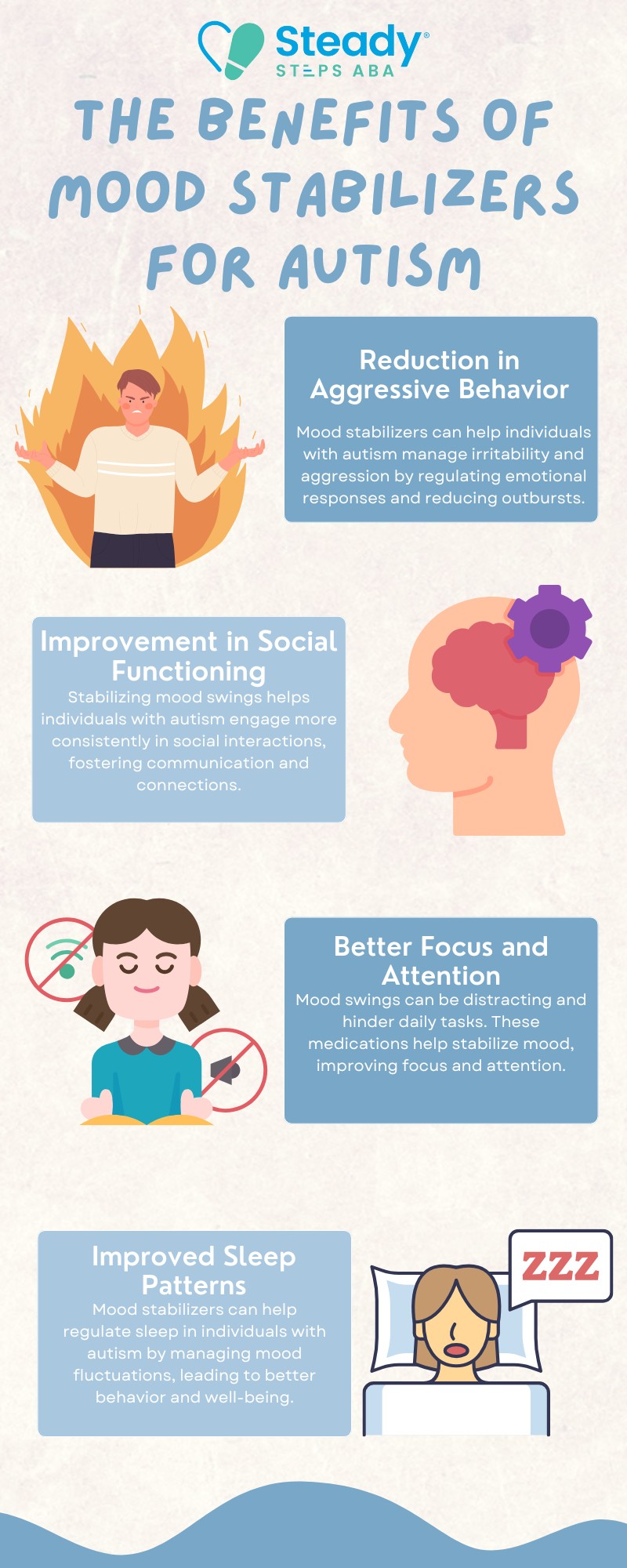Key Points:
- Mood stabilizers are commonly prescribed to individuals with autism, especially those dealing with extreme mood swings, aggression, or irritability.
- While mood stabilizers may help reduce certain symptoms of autism, they are not a cure and should be part of a comprehensive treatment plan.
- It’s essential to monitor side effects and consult with a healthcare provider when considering mood stabilizers for individuals with autism.
Autism Spectrum Disorder (ASD) is a condition that comes with a range of behaviors, including mood swings, irritability, and aggression. In fact, studies indicate that about 28% of children with ASD have shown some form of physical aggression. While mood stabilizers are not a cure for autism, they are sometimes prescribed to help manage these challenging behaviors. However, finding the right dosage is crucial to ensuring their effectiveness while minimizing potential side effects. Parents and caregivers often wonder, do mood stabilizers help with autism?
In many cases, they can be beneficial for reducing intense mood fluctuations and improving overall behavior, but they come with considerations regarding side effects and long-term use. In this article, we’ll dive deeper into how mood stabilizers are used in autism treatment, their benefits, potential risks, and other treatment options available for managing autism-related behaviors.
Do Mood Stabilizers Help with Autism?
Yes, mood stabilizers can help with autism—particularly for managing irritability, aggression, and emotional dysregulation that are common in individuals with ASD. However, it’s important to note that mood stabilizers address specific symptoms and do not treat the core characteristics of autism itself, such as difficulties with social communication or repetitive behaviors.
Mood stabilizers like lithium, valproic acid, and certain anticonvulsants have been shown to help manage mood swings and aggressive behaviors in people with autism. However, their effectiveness can vary widely depending on the individual, and they often need to be used in conjunction with other therapeutic interventions, such as ABA therapy and behavioral treatments.
4 Common Types of Mood Stabilizers for Autism
When it comes to choosing the right mood stabilizers for autism, there are several medications commonly used. These medications help target specific behavioral challenges associated with autism but should always be prescribed and monitored by a healthcare provider. Below are some examples:
1. Lithium
Lithium is traditionally used to treat bipolar disorder but can also help regulate extreme mood swings and reduce aggression in individuals with autism. It can be especially helpful in managing irritability and explosive outbursts.
2. Valproic Acid (Depakote)
Valproic acid is an anticonvulsant often used as a mood stabilizer. It has shown effectiveness in controlling aggression and hyperactivity, particularly in children with autism who also experience seizures.
3. Anticonvulsants
Medications like lamotrigine and carbamazepine are also used as mood stabilizers and can help reduce aggression and mood swings. These medications can be helpful for individuals with autism who have co-occurring seizure disorders.
4. Atypical Antipsychotics
While technically not “mood stabilizers,” medications like risperidone and aripiprazole, which are atypical antipsychotics, are sometimes prescribed for managing aggression, irritability, and severe mood swings in children with autism.

What are the Different Ways to Take Mood Stabilizers for Individuals With Autism?
When it comes to taking mood stabilizers for individuals with autism, there are several methods that can make it easier for both children and adults to follow their treatment plan. Depending on the individual’s preferences, sensory needs, and the specific medication prescribed, different approaches may be more suitable. Here are a few common ways mood stabilizers are taken:
- Oral Tablets or Capsules: This is the most common method of administration. If your child or loved one can swallow pills, this is a straightforward option. You can try offering the medication with a favorite drink or food to make swallowing easier.
- Liquid Form: Some individuals with autism may find liquid medications easier to swallow than tablets or capsules. Liquid mood stabilizers allow for easier adjustments to dosage if needed.
- Chewable Tablets: For those who struggle with swallowing pills, chewable mood stabilizers can be a great alternative. These often come in kid-friendly flavors and can make taking medication feel more like a treat.
- Transdermal Patches: Some medications come in the form of patches that are worn on the skin. This method is often helpful for individuals who have trouble with oral medications.
- Crushed or Mixed with Food: If pills are difficult to swallow, some medications can be crushed or opened and mixed into food or drinks. Always consult with a healthcare provider before altering the form of the medication.
Finding the right method for your child’s needs can help ensure they stick to their treatment plan with less stress.
What are the Risks and Side Effects of Mood Stabilizers for Autism?
While mood stabilizers for autism can offer significant benefits, there are also risks and side effects that parents should be aware of. Just like with any medication, the side effects of mood stabilizers vary from person to person and should be closely monitored. Below are some common side effects:
- Weight Gain: Certain mood stabilizers, particularly atypical antipsychotics, can cause significant weight gain, which may affect a child’s health and self-esteem.
- Sedation or Drowsiness: Some mood stabilizers can cause sedation or drowsiness, which can interfere with daily activities, including learning and social interactions.
- Gastrointestinal Issues: Medications like valproic acid can cause nausea, vomiting, or stomach upset, especially when taken in higher doses.
- Cognitive Impairment: In some cases, mood stabilizers can affect cognitive function, leading to slower processing speeds or difficulty with memory and learning.
- Long-Term Risks: Long-term use of mood stabilizers may increase the risk of developing other health conditions, such as diabetes or cardiovascular problems, depending on the medication. It’s important to monitor for any long-term side effects.

What Other Treatment Options Are Available for Managing Autism?
While mood stabilizers for autism can be helpful, they should not be the sole focus of a treatment plan. Other therapies and interventions play a critical role in managing autism symptoms and improving quality of life. These treatments can complement mood stabilizers, ensuring a more holistic approach to autism care.
Below are some examples of common treatments used for autism:
1. Applied Behavior Analysis (ABA)
ABA therapy is a highly effective treatment for autism that focuses on reinforcing positive behaviors and reducing challenging behaviors. ABA is often considered the gold standard of therapy for autism and can be used alongside mood stabilizers to promote skill development and emotional regulation.
2. Speech Therapy
Many individuals with autism experience difficulties with communication. Speech therapy can help individuals improve their language skills, making it easier to express needs and engage with others.
3. Occupational Therapy (OT)
OT focuses on helping individuals develop daily living skills and sensory processing abilities. For children with autism, OT can help improve motor skills and teach strategies for coping with sensory sensitivities.
4. Social Skills Training
Social skills training can help individuals with autism learn how to navigate social situations, improving their ability to interact with peers and develop friendships.
5. Dietary and Nutritional Support
For some individuals, making dietary changes or incorporating supplements can have a positive impact on behavior and overall health. Omega-3 fatty acids, in particular, have been shown to support brain function and emotional regulation.
Support Your Child With ABA Therapy in Maryland
If you’re looking for comprehensive support for your child’s autism treatment, Steady Steps ABA specializes in ABA therapy in Maryland. While mood stabilizers can help manage certain behavioral challenges, ABA therapy is a proven approach that helps address communication, social skills, and problem behaviors.
At Steady Steps ABA, we provide individualized therapy plans designed to meet the unique needs of each child. Our experienced team works with parents and caregivers to create a holistic treatment plan that integrates behavioral therapy with other medical or therapeutic interventions, including the use of mood stabilizers.
If you’re in Maryland and want to explore how ABA therapy can improve your child’s development, reach out to us today. Together, we can help your child achieve their full potential.



